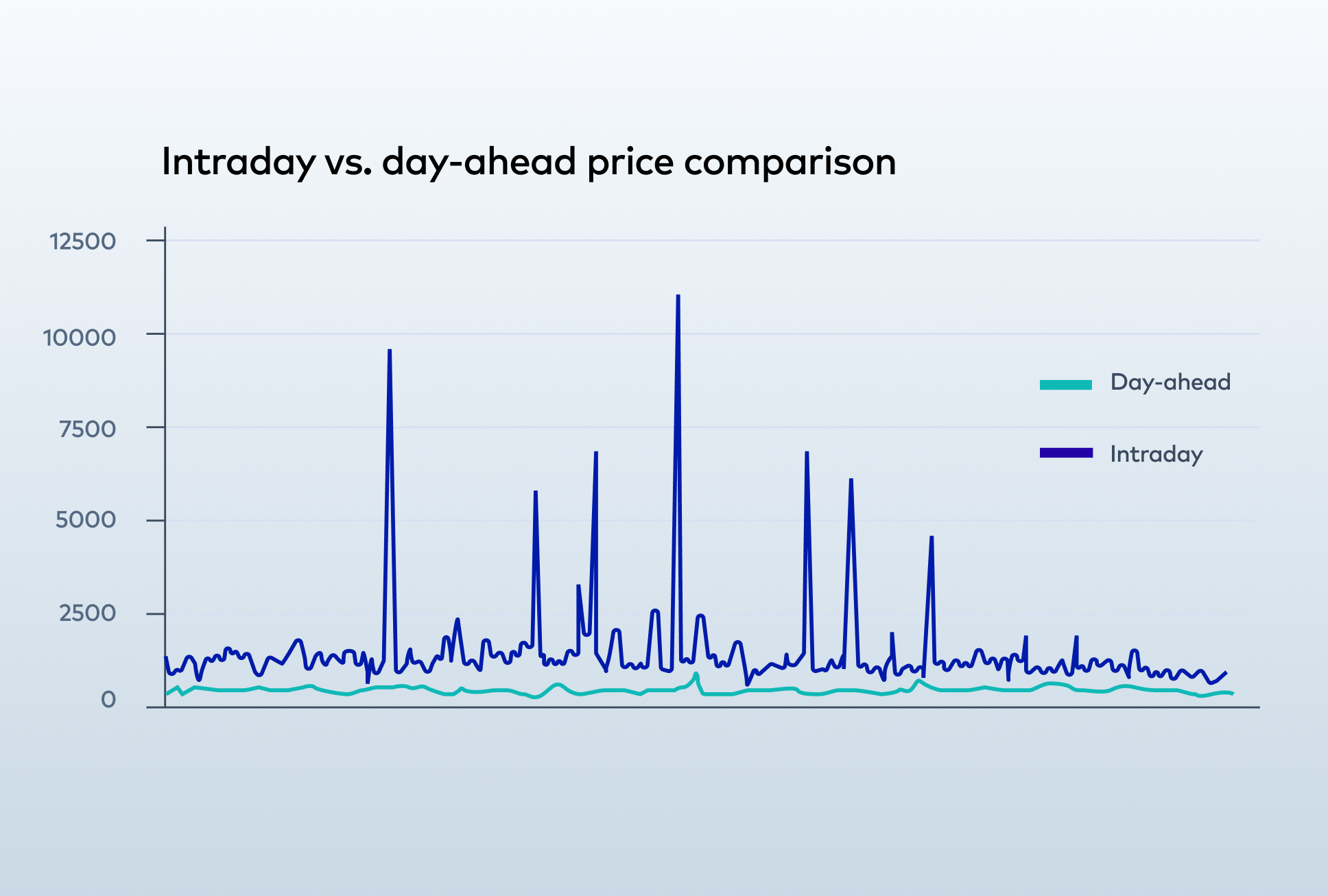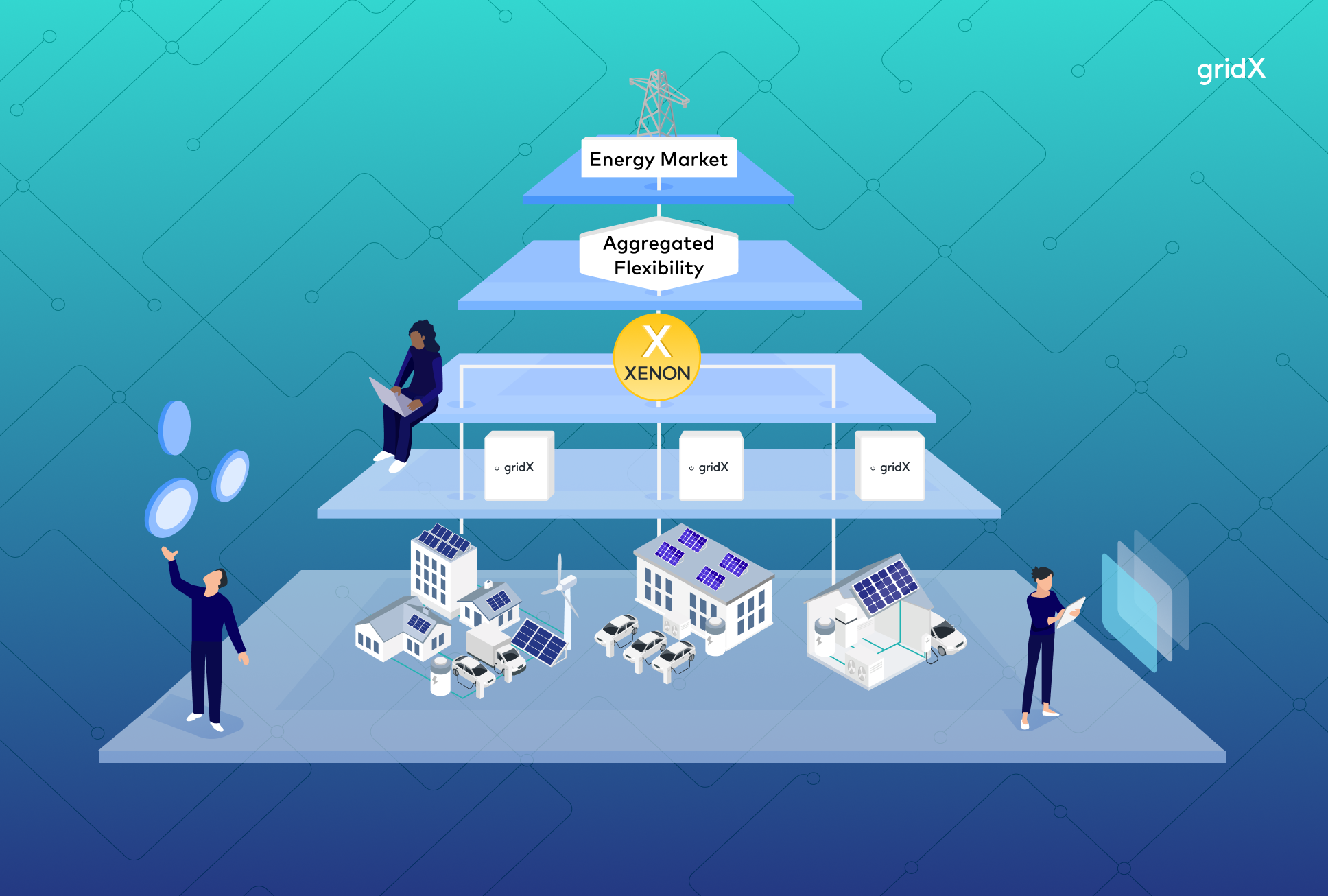EPEX SPOT is Europe’s main marketplace for short-term electricity and flexibility trading, covering day-ahead to real-time delivery. With 400+ members across 19 countries, it operates physical power markets that include auctions, intraday trading, and local flexibility services. As the backbone of wholesale electricity pricing in Western and Central Europe, EPEX SPOT ensures transparent, cross-border market integration.
Why is this important?

For anyone involved in home energy management systems (HEMS), solar or storage installations, or prosumers – homes or businesses that both consume and produce energy – EPEX SPOT is more than just an exchange for big utilities. It defines wholesale electricity prices 24/7, directly shaping what end-users pay or earn. With the rise of renewables and smart energy tech, these market signals are now crucial for small-scale energy assets. The next big opportunity for prosumers is to become flexumers, those who actively shift or trade their energy use based on price and grid signals. Understanding EPEX SPOT is key to tapping into dynamic tariffs, demand side response and energy flexibility.
The day-ahead market: Setting tomorrow’s prices
The Day-Ahead Market on EPEX SPOT is where electricity is traded for next-day delivery through a daily auction at 12:00 CET. Buyers and sellers submit bids for each 15-minute period of the following day. The market-clearing algorithm matches supply and demand to set a single price per hour – the Market Clearing Price (MCP) – paid by all buyers and received by all sellers.
With over 500 TWh traded annually, this market offers deep liquidity and serves as a key reference for wholesale prices across Europe.
Why cross-border coupling matters
EPEX SPOT's day-ahead market is integrated via the Single Day-Ahead Coupling (SDAC) across 19+ countries. This means available electricity flows from low-price areas to high-price ones, as long as grid capacity allows. It aligns prices regionally, improves grid efficiency and ensures cheap renewable energy isn’t stranded.
For HEMS providers and prosumers, this regional price signal condenses continental supply-demand trends into a clear hourly reference, guiding when to consume or store energy.
What’s (hopefully) changing in 2025: 15-minute trading
Previously planned for Spring 2025 but now moved to fall, the day-ahead market will shift from hourly to 15-minute intervals, introducing 96 prices per day instead of 24. This gives more accurate signals, especially for fast-changing sources like solar.
For smart devices and HEMS, this means tighter optimization: think EV charging scheduled to 15-minute windows of ultra-low midday prices. It’s a major step toward unlocking more value from residential flexibility.
The intraday market: Last-minute balancing and flexibility
While the day-ahead market sets the plan, real-life conditions shift fast – solar or wind output may miss forecasts, demand may spike or dip. That’s where the Intraday Market steps in. It allows participants to trade power on the same day of delivery, right up to 5 minutes before real time.
Unlike the day-ahead auction, intraday is continuous – buy and sell orders are matched instantly, around the clock. Trades can be made in hourly, 30-minute or 15-minute intervals, offering the granularity needed to adjust positions close to delivery.

Why intraday trading matters
Intraday markets act as a safety net for last-minute balancing. If a factory needs more power than expected, or a wind farm overdelivers, they can adjust via intraday trades. With Single Intraday Coupling (SIDC) across 20+ countries, this balancing happens across borders too – smoothing price spikes and improving grid stability.
For HEMS providers and prosumers, this is where real-time flexibility pays off. Prices fluctuate throughout the day, signaling energy demand or surplus. Smart systems can react automatically – for example, a home battery might charge at 5 PM if prices plunge due to unexpected wind power.
Local flexibility markets are emerging
EPEX SPOT is also piloting local flexibility auctions, giving DSOs tools to manage congestion. In the UK, over 100,000 decentralized assets – from home batteries to EVs – were connected to a local market platform, enabling demand shifts at the distribution level.
For flexumers, this opens up new ways to earn from their flexibility, not just save. These real-time and local markets are no longer concepts. They’re active, growing and rewarding those ready to respond.
Wholesale price volatility and dynamic tariffs
One of the most direct ways EPEX SPOT impacts small energy users is through dynamic electricity pricing. Currently, dynamic electricity tariffs are typically based on day-ahead market prices, with energy retailers passing these prices on to end users, usually on an hourly basis – and soon, 15-minute intervals. While intraday market prices are not yet directly used for dynamic tariffs, aggregators can optimize energy consumption by incorporating intraday price signals into their strategies for better flexibility management.
That means if electricity is priced at €20/MWh (2 cents/kWh) at 3 PM and €200/MWh (20 cents/kWh) at 7 PM, the consumer sees that difference on their bill. As renewables grow and decarbonization accelerates, wholesale price volatility is increasing, making dynamic tariffs an effective tool to shift demand and unlock flexibility.

Price swings and smart timing
How big can the spread get? On June 26, 2024, the day-ahead price in the German market ranged from €2325.83/MWh at 6 AM to -€0.06/MWh at 1 PM – a massive swing driven by solar surplus at midday and peak demand in the area. That’s not just a market signal, it’s a money-making opportunity for those who can time their usage.
Take a prosumer with a 52 kWh EV battery:
- Charging at peak (6 AM at €2325.83/kWh) = ~€120k
- Charging at off-peak (1 PM at -€0.06/kWh) = get paid ~€3
That’s a €100k difference for the same session due to the extreme volatility that we are experiencing on the spot market.
While fees and retail markups vary, the core value is clear: smart timing saves or even earns money.
Why automation is key
Of course, no one’s watching the market all day. That’s where HEMS comes in – automating when to charge, pre-heat or shift loads based on live price signals. An advanced HEMS responds to thresholds without compromising comfort, turning volatility into opportunity.
By tracking market prices and optimizing when and how to use energy, HEMS makes dynamic pricing practical, helping reduce bills or unlock revenue.
Why it matters for the industry
Dynamic tariffs based on EPEX SPOT are already offered by innovative utilities across Europe. Regulators support them as a way to shift demand and balance a renewable-heavy grid. For HEMS providers, installers and manufacturers, enabling dynamic tariff compatibility is no longer a nice-to-have – it’s becoming essential.
Helping prosumers access and react to real-time pricing not only cuts payback time for PV, batteries or EVs – it builds smarter, more responsive homes that support the grid and benefit from it.
Beyond reducing energy costs, prosumers can actively earn revenue and support the grid by providing flexibility through EPEX SPOT. A capable HEMS or energy management platform unlocks two key use cases:
Wholesale market trading: Intraday flexibility
Prosumers can also monetize flexibility by trading it directly on intraday or imbalance markets. For example, if a platform forecasts that 1,000 homes can reduce heat pump load at 8 PM, it can sell 1 MWh of reduced demand into the market. When the trade is accepted, HEMS at each home responds accordingly – temporarily reducing usage or feeding power back.
This model treats thousands of small assets as one flexible virtual power plant, earning from price fluctuations.
Why aggregation makes it work
Individually, a 5 kW battery can’t enter the market. But aggregated, 1,000 homes provide 5 MW – a scale that matters. Energy aggregators and energy-as-a-service platforms manage this process, while the HEMS handles local control.
Prosumers join under clear terms (e.g. minimum battery reserve, charging windows for EVs) and share in the earnings. The result? Your home energy setup becomes a revenue stream, not just a savings tool.
Implications for HEMS providers and installers
For companies in the HEMS space or those installing smart energy equipment, aligning with EPEX SPOT-driven opportunities is key:

Integrating price signals
Ensure your HEMS or energy management solution can ingest day-ahead and intraday price data (via APIs or data services) and adjust device schedules accordingly. Wholesale-indexed tariffs are becoming common, and your system should be ready to optimize around hourly or 15-min prices. This is a major selling point to end customers – promise them automatic savings by shifting to cheaper hours, which is now feasible thanks to EPEX SPOT price transparency.
Automated load shifting
Common household flexible loads include EV charging, battery charging/discharging, water heating, HVAC (thermostats/heat pumps) and smart appliances. A HEMS can schedule these to run at off-peak EPEX SPOT price times (or pre-run them before an expected peak). By doing so, customers directly save money on dynamic tariffs or time-of-use plans. It also has a societal benefit: smoothing demand peaks and filling midday troughs helps integrate renewable energy. For example, scheduling an EV to charge at noon when solar is abundant and prices are low not only cuts costs but also uses greener energy.
Peak shaving and capacity management
In some regions, capacity charges or peak tariffs penalize users for high peaks in usage. A HEMS can use wholesale price signals as a proxy for grid stress – high prices often coincide with peak system demand. By shaving peaks (temporarily reducing or delaying loads when prices spike), the HEMS can avoid tripping expensive demand thresholds Installers should note that as more utilities consider capacity-based tariffs for even residential customers (already happening in parts of Europe), having an energy controller to cap the household peak by reacting to grid signals will add value.
Aggregation-ready devices
Manufacturers of batteries, EV chargers, heat pumps, etc., should design products that can be enrolled in aggregator programs. This means open communication standards and the ability to accept external control or setpoints. Interoperability (e.g. via standard protocols or a unifying platform like gridX’s XENON Flex) will make it much easier to tie into an aggregated virtual power plant (VPP) that trades on EPEX SPOT or provides balancing services.
If you’re an installer, partnering with an aggregator or using a platform that can “stack” multiple value streams for the customer (savings plus revenue) can differentiate your offering. For instance, a battery could provide backup power (value 1), time-shift solar for self-consumption (value 2), and also participate in grid services or spot trading when idle (value 3) – this value stacking significantly improves ROI.
Expert insights: How XENON Flex powers flexibility trading
Direct access to EPEX SPOT is restricted to licensed market participants, which excludes most prosumers. That’s where aggregators and platforms like gridX’s XENON Flex play a crucial role. XENON Flex connects distributed energy resources – primarily mono-directional EVs, PV systems and heat pumps – to short-term electricity markets and helps turn flexibility into a revenue-generating asset. It forecasts available flexibility, aggregates small assets into a portfolio and executes trading strategies across markets like intraday and imbalance. As Lukas Exel, Product Manager at gridX, explains, XENON Flex enables providers to “move from savings per system to actual revenue per system by making flexibility market-ready.” He adds, “What makes XENON Flex unique is that we make the complexity of decentralized energy resources abstract, allowing traders to seamlessly monetize the flexibility based on reliable information of the available flexibility on an aggregate level.”

This isn’t hypothetical. The value is already being realized. In the Netherlands, XENON Flex has been used by energy service providers to aggregate residential batteries and participate in imbalance optimization. The outcome: up to €6 per day per system, or around €1,800 annually, in added revenue. That income can be split with the end user, reinvested or scaled with additional flexible devices. The more volatility in the market, the higher the potential earnings – making the business case stronger over time.
For HEMS providers, this shifts the value proposition. It’s no longer just about helping customers save – it’s about unlocking new income streams. For flexumers, it means their battery or EV charger isn’t just a passive asset but an active market participant. XENON Flex takes care of the complexity – from dispatch logic to market integration – allowing energy companies to monetize flexibility without building these systems in-house.
The path forward depends on regulation. Flexibility trading requires frameworks that allow aggregators to access markets, and much of Western Europe is moving in that direction. Germany, France, the UK and the Netherlands already support various forms of demand response and third-party aggregation. As local and regional flexibility markets grow, platforms like XENON Flex are ready to scale – proving that decentralization, when well coordinated, delivers value not just to prosumers but to the grid as a whole.



